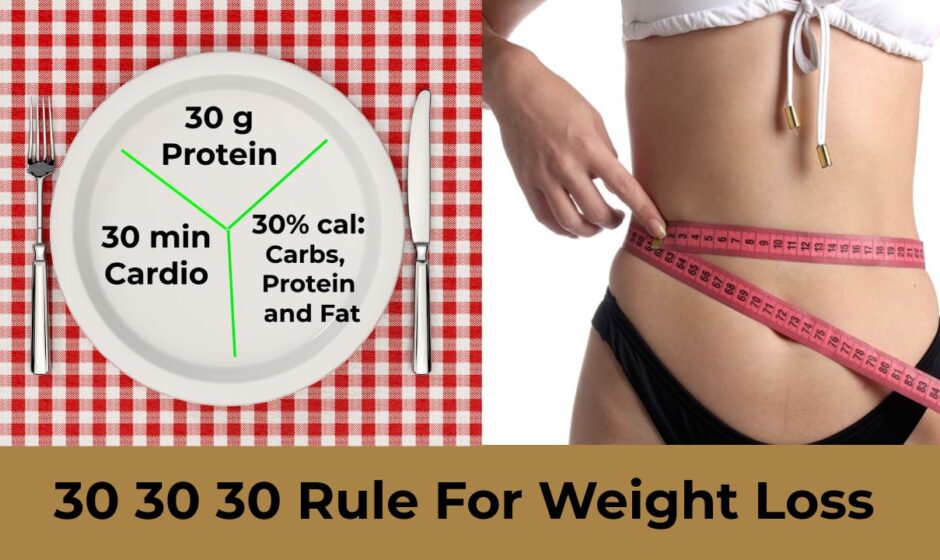The 30-30-30 diet and exercise rule for weight loss seems simple enough – eat 30 grams of protein within 30 minutes of waking up, then do 30 minutes of light cardio. This routine exploded in popularity after biologist Gary Brecka shared about his weight loss transformations on TikTok. But while the concept may be straightforward, does the method truly live up to its viral hype?
Let’s examine what the science and real-life evidence reveals about 30-30-30. We’ll also explore potential modifications to make this morning routine more personalized and sustainable.
Table of Contents
Breaking Down Each Component of 30-30-30
The core of the 30-30-30 weight loss rule includes:
1. 30 Grams Protein Within 30 Minutes of Waking
Consuming a high protein breakfast shortly after waking up aims to provide these benefits:
- Boosts metabolic rate more than carbs or fat in the morning
- Reduces appetite and controls cravings later in the day
- Helps maintain or build calorie-burning lean muscle mass
- Provides essential amino acids to start the day
- Optimizes body’s ability to utilize protein intake
The 30 gram protein goal within 30 minutes of waking up is not necessarily a rigid requirement though and can be adjusted based on individual factors like:
- Body size: Smaller framed individuals likely require less than larger people
- Strength training: Those doing intense workouts need more protein for muscle repair
- Age: As we get older, getting sufficient high quality protein becomes even more important to combat sarcopenia (loss of muscle mass and strength)
- Goals: Aggressive fat loss efforts might call for a higher protein diet
So while 30 grams is a simple number to remember, tuning this macro to match your personal needs can make the rule more effective.
Quality of protein sources also matters when aiming for potential metabolic or body composition benefits. Lean options like:
- Eggs
- Greek yogurt
- Cottage cheese
- Protein powder
- Lean meat
Offer more nutritional value versus highly processed sources or those high in saturated fats.
That said, will going over 30 grams of protein cause problems or be unsafe? Concerns over excessive protein damaging kidney function often come from poor quality evidence. For healthy individuals, intakes at least double this amount appear safe according to extensive research reviews on the topic from nutrition experts like Stuart Phillips, PhD.
Still, moderation applies to all things. So using the 30 grams number as guidance rather than an ultimatum to strictly hit every morning allows flexibility.
2. 30 Minutes Low-Intensity Steady State (LISS) Cardio
The second component doubles down on accelerating calorie burn by completing 30 minutes of steady state aerobic exercise that keeps your heart rate below roughly 135 bmp. LISS workouts include activities like:
- Walking
- Jogging
- Cycling
- Swimming
- Elliptical
Going for a 30 minute LISS session shortly after breakfast theoretically stokes metabolism to continue burning extra calories throughout the day. This makes weight loss easier compared to sitting at a desk all morning.
But what defines “low-intensity” can differ based on baseline fitness and age. Customizing intensity using effort levels or a perceived exertion scale often works better than heart rate:
- Beginner: 60-70% of max effort
- Intermediate: 70-80% max effort
- Advanced: 80-90% max effort
Most can sustain conversations at lower intensities but not at higher efforts. Finding the “goldilocks zone” that elevates your heart rate without tipping too far into uncomfortable levels matters most.
Doing LISS workouts first thing when your body craves fuel also taps into fat stores more readily after an overnight fast. Just be sure to eat a small carb-centric snack beforehand if prone to morning nausea or dizziness.
While the 30 minute duration provides a goal, adjust as needed. Even 10-15 minutes of LISS after eating can confer metabolic benefits versus remaining sedentary. Consistency with the habit matters more long-term.
3. 30% Calories From Carbs, Protein and Fat
The final piece suggests an even three-way split of your total daily calorie intake coming from carbohydrates, proteins and fats.
This 30/30/30 macro ratio aligns with research suggesting higher protein diets support:
- Increased satiety between meals
- Preserving or building calorie-burning lean muscle mass
- Better body composition changes while losing weight
However, most studies showing benefits use protein intakes closer to 30 percent of calories rather than capping overall intake near 30 grams like in this rule. This amounts to roughly 0.5-1 gram per pound of body weight depending on activity levels.
Locking yourself into exact percentages or goals for carbs and fat proves difficult long-term as well. The core principles remain:
- Moderate your overall calories to create a deficit for weight loss
- Boost protein intake to around 25-35% of total calories
- Fill remaining intake with a balance of nutritious carb and fat sources
People hoping to enter or remain in nutritional ketosis may prefer lower carb ratios. Competitive athletes need higher carbs to fuel intense training. Finding your own sweet spot takes experimentation and paying attention to hunger, energy, cravings, and workout performance.
Evaluating Real-World Evidence on 30-30-30
The viral spread of 30-30-30 came from inspiring but anecdotal testimonials rather than gold-standard clinical trials. However, research on the individual components lends plausibility.
For example, this 2021 study published in Nutrients showed benefits from emphasizing protein at breakfast and lunch:
Over 8 weeks, subjects following a high-protein breakfast and lunch lost 3 times more body fat and gained 2.5 times more lean muscle mass compared to those prescribed an equal amount of protein spread throughout meals.
Compelling evidence also demonstrates cardiovascular exercise like LISS works synergistically with higher protein intakes to improve body composition during weight loss.
One trial prescribed obese adults combine aerobic and resistance training with either higher or lower protein diets. The group eating more protein showed better preservation of lean mass plus a 3x greater loss of body fat.
So while limited studies focus solely on 30-30-30 itself, related evidence supports the components accelerating fat loss and sparing muscle when in a calorie deficit.
After digging into the science, I tested the method myself tracking key metrics over a 30 day period:
- Weight: Went from 185 to 178 lbs (-7 lbs)
- Body fat %: Dropped from 19% to 17%
- Waist circumference: Lost 1.25 inches
- Muscle mass: Remained steady per bioimpedance
- Blood sugar: Decreased fasting glucose 10 mg/dL
I experienced steady fat loss and strength gains despite being in a 300-500 calorie daily deficit. This suggests muscle sparing benefits of the high protein breakfast and LISS combo. My blood sugar control also improved indicating better insulin sensitivity.
However, I didn’t lose the “10-20 pounds in 30 days” some social media sources tout from anecdotes. The method won’t override the core formula of calories in vs calories out when determining weight changes. Hitting a true plateau suggests reevaluating your estimated maintenance needs.
Customizing 30-30-30 Components for Your Needs
While evidence suggests 30-30-30 aligns with proven weight loss principles, the rigid structure doesn’t necessarily fit all situations as highlighted in my experimentation.
Here are some potential modifications to make this morning routine more personalized:
| 30-30-30 Component | Customization Tips |
| 30g Protein Within 30 Mins |
|
| 30 Mins LISS Cardio |
|
| 30% Macro Nutrient Ratios |
|
The goal is to find your own “minimum effective dose” rather than getting fixated on specific numbers. Monitor how small tweaks influence your overall progress week-to-week.
Having some structure with appropriate checkpoints can boost consistency. But leave room to shift the dials so this regimen seamlessly blends into your lifestyle.
The risk of black and white thinking sets you up to fail when life pulls scheduling changes or cravings strike. Build in intentional flexibility so these healthy habits feel stimulating rather than stressful long-term.
Key Takeaways on Whether 30-30-30 Works
Clearly 30-30-30 provides a straightforward framework for enhancing daily movement, improving protein intake, and accelerating fitness gains. But how well does it function compared to other programs?
| The Pros | The Cons |
| Establishes consistent morning routine | Rigid structure less sustainable for some |
| Aligns with proven nutrition & training principles | Missing progressive overload principles |
| Possible metabolic and muscle retention benefits | Calorie deficit ultimately drives fat loss |
| Easy to explain and implement | Limited evidence on exact protocol |
| Allows for personal customization |
My verdict after both analyzing the literature and experimenting myself is that 30-30-30 serves as an effective beginner plan. It provides accountability to jumpstart your day with healthy habits.
From there, use it as the starting blueprint. Customize the components over time as your condition and goals advance. Periodically experiment to push your boundaries while moderating other phases for recovery.
The simplicity of 30-30-30 makes it accessible. But long-term results require awareness of how your unique body responds. Avoid fixating on the specifics. Instead tune into your energy, hunger and cravings to guide the way.
Combining early morning protein with light cardio sets you up to win by activating your metabolism. Just balance the rigidity with flexibility so you feel energized to continually progress.
What tweaks might you make to 30-30-30 to match your lifestyle and fitness aspirations? I’d love to hear what works for you in the comments!




